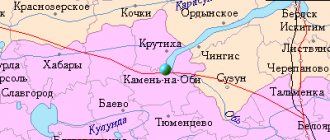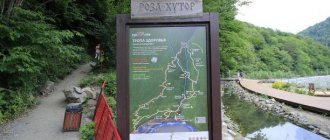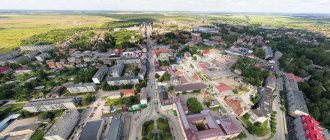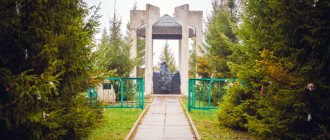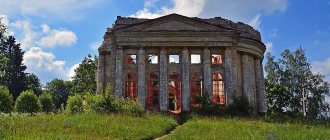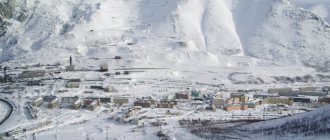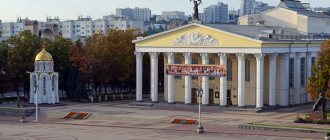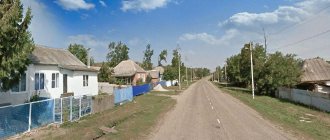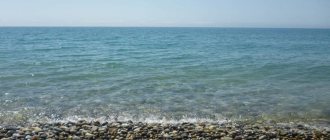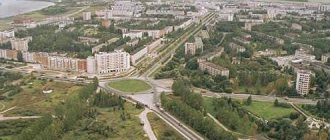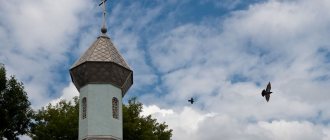Project on the topic: “From the history of Kamensk - Shakhtinsky”
Project on:
“From the history of Kamensk - Shakhtinsky”
Kamensk - Shakhtinsky. Attractions.
Millions of people have seen the largest sights of Kamensk-Shakhtinsky without even visiting the city. And just follow the federal highway M4 to the resorts of the Black Sea and Caucasian Mineral Waters. These are the grandiose museum and exhibition complexes “Legends of the USSR”, “Patriot”, “Bike Hotel”. Every year thousands of people not only pass by, but also stop in Kamensk, visiting these unusual places.
The city of Kamensk-Shakhtinsky is located on the banks of the Seversky Donets River (the right tributary of the Don). The climate here is temperate continental, steppe, with mild, little snowy winters and hot, long summers.
The territory for the final justification of the village of Kamenskaya was chosen by General Platov. The territory was built up according to a rectangular layout, in accordance with the general plan, like the capital of the Don Army - the city of Novocherkassk. By the beginning of the 20th century, Kamenskaya, the capital of the Donetsk district, became the largest of the Voysk villages.
Stele on the highway, with the red and white coat of arms of the city.
In 1927, the village was renamed the city of Kamensk, and since 1929 it began to be called Kamensk-Shakhtinsky. During the Great Patriotic War, several young residents of Kamensk participated in the famous Krasnodon underground sabotage organization “Young Guard”. Also, a group of pioneers from the city were captured by the Nazis for helping the advancing Soviet troops and, after being tortured, were shot.
Main streets
Karl Marx Avenue (formerly Donetsk Avenue) is a wide boulevard stretching from the Seversky Donets embankment for two and a half kilometers from northeast to southwest. Lenin Street (formerly Starovokzalnaya, then Sovetskaya) - from the railway station and to the Seversky Donets, perpendicular to Marx Avenue. Voroshilov Street (formerly Grekovskaya, then 40 Let Oktyabrya Street) is the main thoroughfare connecting the old and new towns.
The ancient building of a gymnasium for girls (now Gymnasium No. 12).
On these three main streets there are almost all government administrative buildings, many cultural institutions, retail and office facilities, etc. Street of Heroes of Pioneers (formerly Linenaya) is a transport highway bypassing the central part of the city, on one of the sections coinciding with the M4 Don federal highway. Here are the most famous sights of Kamensk-Shakhtinsky, the creator of which was the general director of Kamenskgaz, entrepreneur and great enthusiast Vladimir Beschetny. The Bike Hotel, the USSR and Patriot hotels, with large museum and exhibition complexes, have a convenient location for travelers heading along the M4 to the Black Sea resorts of the Krasnodar and Crimean coasts, as well as to the health resorts of the Caucasian mineral waters. These hotels are located halfway from Moscow to the indicated sites. Therefore, many people traveling by car are caught by night precisely on this part of the journey. The creators of the complexes made sure that their visitors were not only comfortable, but also interested, and therefore created unique museums and art objects next to the hotels.
Bike hotel
P
The first Bike Hotel to open was in 2009. Its original interior design is completely in keeping with the spirit of the biker subculture, worked out to the smallest detail. There are no analogues in Russia. In the halls there are exhibits of a rich collection of motorcycles from different years - two- and three-wheeled, factory models and homemade ones. The headboards of the beds in the rooms are made in the shape of motorcycles, the tables with transparent tabletops are made of motorcycle wheels; instead of chair legs there are also motorcycle wheels. The skeleton of the Ghost Rider is clearly visible from the M4 motorway. It is impossible to drive past the Bike Hotel and not notice it: in front of the building there is a huge figure of the Ghost Rider: a motorcycle with a frame in the shape of a skeleton. The eyes of the skull glow in the dark, and the entire sculpture is also complemented by beautiful lighting.
Museum "Legends of the USSR" and Hotel "USSR"
The first hall of the museum, with an area of 800 m², was opened on the May holidays of 2016; the second, with an area of 730 m², will be completed exactly one year later. The museum's exposition includes a rich collection of cars, motorcycles, and bicycles from the times of the Soviet Union, including the 30s; war and post-war years; authentic samples of electrical engineering, household items and household items of Soviet families. Tape recorders and record players; radios and transistors; watches and cameras; TVs and telephones; samovars and typewriters and much, much more; award medals, badges, coins, banknotes from the times of the USSR; weapons and ammunition from the Great Patriotic War.
Theme park - museum complex of military equipment "Patriot"
It was opened in May 2021 opposite the Legends of the USSR Museum. This object became another unique masterpiece of Vladimir Beschetny, and also a branch of the military-patriotic Park of Culture and Recreation of the Armed Forces of the Russian Federation “Patriot”, in Kubinka, Moscow region. This time, a military theme was chosen and developed in every possible way. Here, on an area of one hectare, there is an exhibition of samples of weapons and military equipment, where you can see and touch everything: tanks, armored personnel carriers, artillery pieces, aircraft, army sports and training facilities. The design of this developing park includes a training track for driving military equipment; life-size partisan village; dugouts; parachute tower; full-fledged shooting range. The complex is also used for training of teenage military-patriotic clubs and organizations.
Museum of Decorative and Applied Arts and Folk Art (formerly local history museum)
The Kamensk Museum of History and Local Lore was founded in 1969, first as a public and then as a state cultural institution. initiative of the Council of War and Labor Veterans of the city. In 2003 it was renamed the Museum of Decorative and Applied Arts. Fifteen thematic collections (very rich and varied in content) are offered to visitors: “Ethnography” – objects of traditional Cossack life. The most valuable exhibits are the attribute of the ataman power of the nasek (XVIII century), handmade jewelry of the XVII-XX centuries) “Weapons” - authentic examples of firearms and bladed weapons of the early XIX – XX centuries. “Written sources” – personal archives of participants in the Civil and Great Patriotic Wars, metric books of churches in Kamenskaya Stanitsa. “Decorative and applied arts” – works of folk crafts of various styles. “Painting” – icons (from the 18th century), paintings by local artists. “Sculpture” – figurines made of faience and using the iron casting technique. “Graphics” – old posters, postcards, labels. “Numismatics” is a collection of coins (the oldest is the ancient coin of the Bosporan kingdom). “Archaeology” – dishes, weapons of ancient people found during excavations of local burial mounds. “Natural-scientific” - stuffed modern animals and remains of relict animals and birds, samples of vegetation and minerals. Photo”, “Radio equipment and photographic equipment”, “Souvenirs”, “Watches”, “Toys” - original exhibits from the end of the 19th century to the 80s/90s of the 20th century.
Museum of Nature of the Don Region "House of Nature"
This cultural institution widely presents the flora and fauna of the Don region, a large collection of stuffed animals and birds and thematic compositions from them. Located in a building dating back to the early 20th century, known as Marusina Dacha. The museum is located in the area of the largest park in Kamensk-Shakhtinsky - Mayakovsky Park.
Park named after Mayakovsky
Park named after Mayakovsky is located in the northwestern part of the city. In fact, this is a forest park, a large green area on the banks of the Seversky Donets River, between the lane. Pochtovym, per. Station, Dachnaya Street and the western part of the city outskirts. The park area is 44 hectares. The park was created in the 1950s. At the same time, the Palace of Culture, a beautiful building in the spirit of Stalinist architecture, and a stadium were built here. There are walking paths and benches for relaxation.
Central Park of Culture and Leisure named after Gorky
This is the oldest city park, founded as a public village garden in 1887. In 1936, the city garden received the name of Maxim Gorky. Sculptures were installed. On holidays and weekends a brass band played. The heyday of the park came in the 1960s and 70s, when, according to the fashion of that time, there was an open dance floor. In the evenings, the local vocal and instrumental ensemble “Altair” performed there, enjoying great popularity. The dance floor is a thing of the past, but the attractions - updated or built anew - continue to function in this park.
Central city beach No. 1 “Volna”
The central municipal beach is located on the northern outskirts of the city. It occupies an area of 0.6 hectares and can freely accommodate up to three thousand vacationers at the same time. Its history dates back to the end of the 19th century (at that time it was separate for men and women). After an era of general ruin, it was refurbished in the 1930s: benches, changing cabins, sunshades, drink and ice cream kiosks, cafes. This beach was famous for its unique sand: light, with an original large structure. After the war, this sand was scooped up: it was loaded directly from the beach for construction needs. Subsequently, during the new development of the municipal recreation site, sand was transported from quarries, but the quality was significantly inferior to the previous one.
Landscape park "Loga"
Another talented local businessman-enthusiast, Sergei Kushnarenko, created a stunning park in the Staraya Stanitsa area, a unique masterpiece of landscape design. In this place of cultural recreation there are beautiful gazebos and bridges on the picturesque banks of the river and pond, sculptural compositions in folklore and fairy-tale styles, well-groomed exquisite flower beds, alpine slides, a rock park, “Through the Looking Glass Park”, a musical fountain, a man-made waterfall, a children’s train, a cafe and a restaurant, equipped barbecue area for relaxation. In the center of the park there is a huge playground. The “living corner” is home to squirrels and fallow deer, peacocks and pheasants, parrots and ornamental chickens. Ducks, swans, turtles, and large goldfish swim in the ponds. Loga Park amazes not only with its beauty, but also with its scope. This is a real fairy tale for both children and adults.
Palace of Culture named after Gagarin
Along with the Mayakovsky Palace of Culture, one of the interesting historical buildings of the city is the three-story Gagarin Palace of Culture (originally the Textile Workers' Palace of Culture), opened in 1953. This is an architectural monument of the Stalin era. Its portico consists of eleven columns. Risalits are made along the edges, on the front parts of which intricate bas-reliefs are arranged. There are two separate wings built on both sides of the palace. Until now, the Palace of Culture named after Gagarin remains one of the main cultural centers of the city, promoting the creative development of children and interesting leisure time for adults. There are about fifty clubs for all ages: singing, dancing, sports, etc.
The building of the former Village Council and the Noble Club
A house in the classicist style, built in the mid-19th century, in which the village administration was originally located, and since 1871 (in the same place) the Noble Club began operating. The civil war had not yet ended, and the building, in 1919, had already been handed over to the children. Until 1991, the House of Pioneers operated here, now it is the Center for the Development of Creativity for Children and Youth.
Monuments of Kamensk-Shakhtinsky
In Kamensk-Shakhtinsky there are four large life-size monuments to Lenin (on Truda Square, at the intersection of Lenin Street with Karl Marx Avenue, in the Mayakovsky Park and in the Zavodskoye microdistrict in front of the Palace of Culture of Mechanical Engineers) and one to Marx.
Monument to the Pioneer Heroes
On the central street of the city - Karl Marx Avenue, in Pionersky Square, since 1967 there has been a monument to the Pioneer Heroes who died at the hands of the Nazis in 1943. The names of all child heroes who died for their homeland are carved on the stone stele.
Memorial complex "Heroes of the Civil and Great Patriotic War"
The opening of the memorial took place on May 9, 1971. This is a sculptural group of figures of three Soviet soldiers, a concrete stele, T-34 and T-70 tanks on pedestals, plates with the names of fallen Red Army soldiers, underground fighters, Soviet soldiers, a star-shaped plate with the Eternal Flame. The warrior in the center of the composition holds a bowed banner in his hands.
The T-34 tank was added to the memorial only in 1990. This tank with a guards badge on the turret, tail number 62 and the inscription “Tambov collective farmer” fell through the ice in the winter of 1943, but in the summer of 1989 it was raised from the bottom of the river and, after restoration, took its place in its “eternal parking lot.”
Bust of General Platov
Matvey Ivanovich Platov - a participant in all the wars of the Russian Empire of the late 18th - early 19th centuries, including the Patriotic War of 1812, he held the position of ataman of the Don Army from 1801 and personally indicated the place for the construction of the new Kamenskaya village, on which the city still stands . The bust of General Platov was inaugurated in 2003 near the Holy Protection Church on Shchadenko Square, which since September 2010 has been called Platov Square.
Sculptural composition “Student Date”
Another interesting work by the Ushakovs is the sculptural composition “Student Date”. It depicts a park bench on which a girl sits with a book on her lap. She talks with a young man with a book in his hands.
Location: opposite the building of the Kamensky Chemical-Mechanical College, in the square of Labor Square.
Church of the Intercession of the Blessed Virgin Mary
An Orthodox church founded on October 14, 1991, on the day of the Intercession of the Most Holy Theotokos, near the place where the Church of Peter and Paul, unfinished and dismantled in 1921, was located. The temple was opened on October 14, 2003. It operates a Sunday school, a parish library, a charity canteen, a sisterhood, and a church choir.
Church of the Life-Giving Trinity (Holy Trinity Church)
Orthodox church, built in 1997-2003. Divine services have been held since 1998, and in 2003, bells were installed on the belfry of the Holy Trinity Church. A particle of the holy relics of St. Tikhon of Zadonsk is kept in the church.
Church of St. Andrew the First-Called
A beautiful church in the style of old Russian wooden architecture was built in 2012-2015 in the Likhovsky microdistrict.
In general, Kamensk-Shakhtinsky is a small, green, well-equipped city in the South of Russia, with a predominance of the private sector. A city with a rich history, which is especially felt in its central part.
The station in the milestones of history.
The first railway station of the Kamenskaya station was built in 1871 near the beginning of the current street. Lenin (north of the current one) and this street began to be called Vokzalnaya.
In 1912, another station was built near the beginning of the current street. Ordzhonikidze. This street began to be called Novo-Vokzalnaya, and Vokzalnaya was renamed Staro-Vokzalnaya. During the Great Patriotic War and the occupation of the city by Nazi troops in 1942, the station was destroyed.
The modern (current) station building was built in 1951 according to a standard design by the Kharkov Bureau.
Stanitsa Kamenskaya. Kirova Street - lane. Volodarsky.
DASHING. Station Square.
The station square began to be called after its location - opposite the Likhaya station. But you can still hear another name from people of the older generation - Labor Square. It was here, opposite the management building of the Likhovsky branch of the Southern Eastern Railway, that the leaders of production and labor collectives who won various socialist competitions were honored. There were meetings and partings.
Stanitsa Kamenskaya in 1671-1927.
The city has been known since 1671 as a Cossack settlement, which initially arose near the Malaya Kamenka River (from which it received its name), then moved to the mouth of the Glubokaya River, and then for a long time was located on the left bank of the Seversky Donets, on the site of the modern Staraya Stanitsa (the so-called Fourth resettlement). During the spring flood, the settlement was flooded by the river, so in 1805 the villagers turned to the military administration with a petition to relocate to the right high bank of the Donets.
However, a war with Napoleonic France soon broke out. Military ataman Matvey Ivanovich Platov led the Don regiments to war. Many Kamenets in those regiments also left. There was no time for relocation. Only in 1817, having received the go-ahead from the authorities, the Kamensk Cossacks began to gradually move to the right bank of the Donets and build up between the villages of Rygin and Kosonogovka that had existed since the end of the 18th century. Most of the residents managed to move to a new place allocated for the village, where Kamensk-Shakhtinsky now stands. The territory of the final justification of Kamenskaya was indicated by the cavalry general, ataman of the Don Cossack army M.I. Platov, who further contributed to the development of the village. Kamensk was rebuilt according to a rectangular layout in accordance with the master plan of the architect F. P. Devolan, who was, in particular, the first architect of the capital of the Don Army region - Novocherkassk.
The main street of the young village, called Donetsk Prospekt, stretched along an ancient road, which later became a postal route. On January 18, 1812, the grand opening of the parish school took place in Kamenskaya. Since 1819, a four-year school began to operate, into which graduates of the parish school entered.
The village of Kamenskaya was the center of the Donetsk district, the seat of the district authorities. The district included the entire northeast of the land of the Don Army, which included 7, and later (by 1917) 15 villages. At the beginning of the 20th century, Kamenskaya was already the largest of the Don villages. Thanks to the advent of the railway, its commercial importance grew.
Since 1894, a military vocational school operated in a three-story building on Donetsk Avenue. The establishment had a tailor's, hat-tailor's, saddle and forging departments and trained craftsmen for Cossack units. Students came to Kamenskaya to study from different villages and volosts of the district. In the fall of 1903, a real school opened. In 1912, a women's state gymnasium was built; there was also a private women's gymnasium by F. M. Mazurenko. The second floor of the house of the merchant Shevkoplyasov was occupied by a men's state gymnasium.
In January 1918, a congress of representatives of front-line Cossack regiments was held in the village, at which the Don Cossack Military Revolutionary Committee, headed by F. G. Podtyolkov and M. V. Krivoshlykov, was elected, which proclaimed Soviet power in the Don. Many Cossacks of the village of Kamenskaya were drawn into the whirlpool of the civil war on the side of both the Red and White armies.
Until 1920, the village of Kamenskaya was part of the Great Don Army.
In 1920-1924, the village was part of the Donetsk province of the Ukrainian SSR, subordinate directly to the city of Lugansk. In November 1924, the North Caucasus Territory was created, which included the Shakhtinsky District with the Kamensky District and its center - the village of Kamenskaya.
March 28, 1927 village
received the status
of a city
called
Kamensk
.
Since August 9, 1929, the city of Kamensk has been officially named Kamensk-Shakhtinsky
.
The fame of Kamensk-Shakhtinsky.
- In the winter of 1877-1878, the publicist and socialist theorist G. V. Plekhanov stayed in the village of Kamenskaya. He wrote two notes for the populist newspaper “Land and Freedom” under the general title “Stanitsa Kamenskaya”. Most of them were devoted to the unrest of the Cossacks in the nearby village of Lugansk (now a village 15 km from the city of Lugansk).
- The poet Nikolai Oleinikov was born in the village of Kamenskaya.
- In 1957-1958, film director Sergei Gerasimov and his film crew lived in Kamensk during the filming of the film “Quiet Don (1958)”. Some episodes of the film were filmed in the city itself, some in the nearby village of Bagaevskaya and the Dichensky farm.
- The city also hosted the filming of the feature films “It Happened, Right!?.” (1973) (directed by F. S. Slidovker), “Male Talisman” (1995) (directed by B. S. Galkin) and some episodes of the film “The Fate of a Man” (1959) (directed by S. F. Bondarchuk).
- The main square of the city is Labor Square, during the time of the village of Kamenskaya it was named Nativity of Christ
, after the name of the Church of the Nativity of Christ, erected in the village in 1885 and demolished in 1960. In 1912, the Russian aviator Sergei Utochkin, making public flights in some Russian cities, visited the village of Kamenskaya, landing on Nativity Square.
- The Church of the Nativity of Christ was opened in 1886; it operated during the Great Patriotic War. It was closed in 1950. A scene of a mass Cossack prayer service on the occasion of the outbreak of the 1914 war was filmed near the temple for the film “Quiet Don”. In 1960 the temple was demolished. Now on this site there is a memorial to fallen soldiers. A memorial cross commemorating the destroyed temple was also installed.
- In 1914 on Novoselovskaya street. (later Petropavlovskaya, now Shchadenko) construction began on the Temple of the Apostles Peter and Paul, which was erected under domes, but due to the First World War its construction was suspended. In 1921, the temple was destroyed, and a park and square were formed on this site, bearing the name of Shchadenko. Since September 2010, the square has been named after Platov. On part of the square, a new Church of the Intercession of the Virgin Mary was built and a memorial cross was erected about the destroyed temple.
- Three residents of the city were participants in the Olympic torch relay of the 2014 Olympics: Ulyana Donskova, Alexander Ponomarenko, Alexander Zyryanov.
- In June 2012, a Russian bike festival took place in Kamensk, where near the bike hotel on the highway M4
A monument to the dead bikers was unveiled.
- In 1994-1995 the city accepted refugees from Chechnya in August 2008 from the Georgian-South Ossetian conflict zone. In June-August 2014, the city's railway and bus stations became an intermediate point for thousands of refugees from the Luhansk region who left their homes due to the fighting in eastern Ukraine.
- There are four monuments to V.I. Lenin in the city - on Labor Square, at the intersection of Lenin Street with Karl Marx Avenue, in the park named after. Mayakovsky and in the Zavodskoye microdistrict in front of the Palace of Culture of Mechanical Engineers:
Monuments to Lenin
In 1953, the Palace of Culture of Textile Workers was built in Kamensk, and was a place of rest for workers of the Khimvolokno production association (now the Gagarin House of Culture). Its portico consists of 10 columns. On the sides there are risalits, on the front of which there are bas-reliefs. There are also two separate outbuildings to the left and right of the palace.
Bas-reliefs on the front sides of the Palace of Culture
